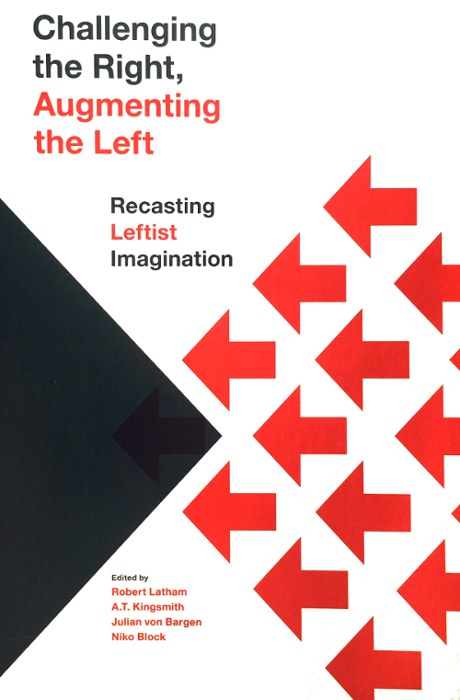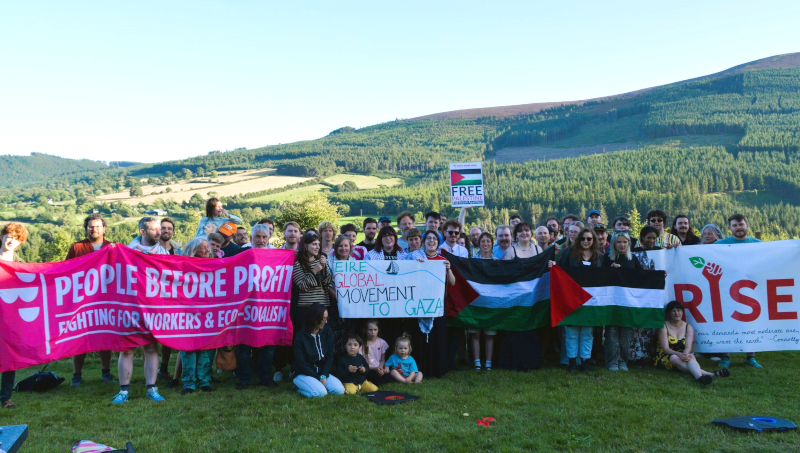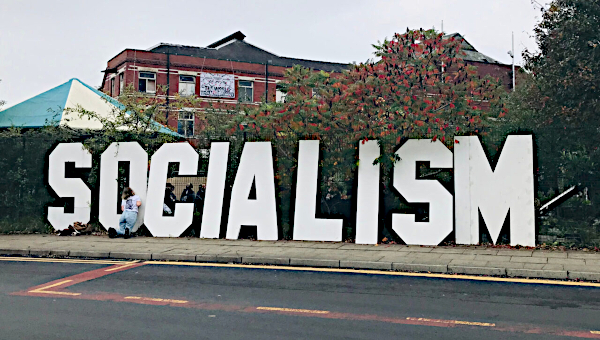Augmenting the Left: Challenging the Right, Reimagining Transformation
The ongoing wave of action for the defunding and abolition of armed police has provoked a familiar yet unresolved series of questions for the left. Momentous though the movement may be in its scope and demands, it nonetheless now confronts a series of political obstacles, and will need to maintain an expansive coalition of activists and supporters to achieve its long-term goals. The danger, as we witnessed with other recent uprisings such as Idle No More or the first wave of Black Lives Matter protests, is that the movement will dissipate while its organizers are scrambling to simultaneously maintain its focus and expand its support base by broadening their political analysis.
Both of these tasks must be accomplished by any successful movement, and yet they can easily contradict each other. In the context of today’s defunding movement, the specific demand for the reduction of armed police must remain at the forefront of public discussion in order for concrete progress to occur; but at the same time, the success of police defunding seems equally contingent upon its coupling with anti-poverty initiatives that will reduce the concrete drivers of violent crime in heavily policed communities. In the difficult moments when movement organizers begin explaining that a racially-oriented movement is not just about race or that a class-based movement is not just about class, centrist and right-wing actors are quick to ridicule the inevitably ambitious nature of the left’s demands.
Following a decade in which this cycle has occurred several times over, the new essay collection Challenging the Right, Augmenting the Left confronts the complexity and interconnectedness of the issues that movements for social justice face today. Initiated in the wake of Donald Trump’s inauguration, the volume – edited by Robert Latham, A.T. Kingsmith, Julian von Bargen, and myself – broadly examines the obstacles and opportunities for movement politics at the end of an extremely complicated decade.
Democratic Uprisings
Beginning in January 2011, democratic uprisings across the Arab world rapidly toppled four governments and destabilized many more. Across Europe and North America, it had by then become obvious that any reforms stemming from the global financial crisis would be purely technocratic, and not redistributive. For a left weary of liberal subterfuge and apology, the spectacle of the Egyptian revolution in Cairo’s Tahrir Square was especially inspiring. What if people everywhere were to occupy key urban spaces and refuse to leave until their demands were met? In September of that year, the Occupy movement spread across the globe with a force that most would never have imagined possible. For several weeks, rising economic inequality became the top story even in the mainstream media. A stunning number of politicians acknowledged the disturbing concentration of wealth and income within the top one percent of their societies, and the proponents of business-friendly politics, it seemed, suddenly transformed from voices of reason into sweaty, stammering grifters pleading before an angry jury.
It looked for a moment as though change was inevitable, and yet the movement declined almost as fast as it rose. Ironically, the original poster for Occupy Wall Street read, “What is our one demand?” Whereas the demand for democracy resonated across the Arab Spring, Occupy never answered this simple question, and its lack of clear objectives led to growing impatience from the mainstream press. The movement from the start was also debilitated by internal disagreements and a lack of organization stemming from competing partisan and anarchist tendencies, and throughout the last two months of the year the encampments were gradually stamped out by direct state repression.
Not only did these transnational revolutionary waves fail to achieve their initial promise; eight years on, the forces of reactionary bigotry are now more powerful than any of us had predicted. Even for leftists who over the past three decades have ridiculed the assumption that the age of global liberalism was neigh, the recent surge of nationalist authoritarianism across the Philippines, India, Europe, Brazil and the US has been dizzying. The Arab uprisings, meanwhile, have been either repressed by reconstituted dictatorships or, in the cases of Syria, Libya and Yemen, collapsed into civil wars that persist to this day.
In a nutshell, the events of the past decade have made it clear that the hand of history will not intervene to neutralize the crises of capitalism. On the contrary, capitalism’s self-reinforcing tendencies are strong enough to ensure that its own innate crises, specifically financial and environmental crises, will never spontaneously ignite systemic change. Rather, the transformative crisis must be a political one, charged with active discussion, organizing and solidarity. This in turn raises the question of what kinds of opportunities for ideological transformation exist in the twenty-first century. Will elite interests succeed in perpetuating capitalist ideology, or will their increasingly obvious hypocrisy foment resistance?
Many on the left now talk about Occupy with disdain, try to forget about it, or even pretend that they were never involved. But in light of the work that needs to be done, I believe its history is instructive for a number of reasons. First, it was the single most important moment of consciousness-raising in recent memory. In its wake the concept of class conflict re-emerged, the socialist left became increasingly self-confident in North America, and a few key public intellectuals amplified their criticism of growing wealth and income inequality (Chomsky 2012; Stiglitz 2013; Piketty 2014). Second, we learned that the tactic of occupying public spaces carries major risks but does in fact work in garnering attention, and could probably succeed in pressing specific demands if it were more coherently organized. Third, we learned that there are thousands of people who are still drawn to the idea of revolutionary politics, but are only likely to hit the streets at a moment when their imaginations have been sparked – a moment when the battle suddenly seems winnable. And fourth, we learned that it is also unwise to launch a movement before concrete demands have been articulated. These last two themes – of narratives and vision – deserve some elaboration. This essay (which is lightly modified from my own introduction) will draw from the contributions in Challenging the Right, Augmenting the Left to argue that the current left’s shortcomings in these fields have rendered it difficult to develop a narrative and vision that garners popular support.
Radical Recasting of Leftist Imagination
Indeed, the central argument of this book is that the crises of the twenty-first century call for a radical recasting of the leftist imagination. This process involves building bridges between the real and the imaginary, so that the path to achieving political goals is plain to see. Accordingly, the articulation of leftist goals must resonate with people in concrete ways, so that it becomes obvious how the achievement of those goals would improve their day-to-day lives. The left, in this sense, must appeal to people’s existing identities and not condescend the general public as victims of “false consciousness.” All this means building movements of continual improvement, and refusing to ask already-vulnerable people for short-term losses on the abstract promise of long-term gains. This project also demands that we understand precisely why right-wing ideology retains a popular appeal in so many spaces.
By augmenting the left, then, we mean adapting it to the crises of our time, and even getting ahead of them. We mean abandoning some of the wishful thinking that has persisted in left-wing thought, reconciling certain counterproductive divisions within the left, and strategizing for the work that lies ahead in this century. Five specific subjects call for attention, which are addressed in each of the book’s sections. First, the left needs new ways to engage working class people who are already disillusioned with the system they inhabit, but who are nonetheless estranged from anti-capitalist organizing. Second, the left must find ways to undermine reactionary currents of ethno-nationalism while at the same time supporting anti-colonial movements. Third, the left needs to think about how to strategically build power both inside and outside the state apparatus. Fourth, the environmental crises of the twenty-first century, especially climate change, demand new forms of resistance that will have to challenge our existing systems of production in unprecedented ways. And finally, the left must understand the cultural dimensions of popular ideology in order to effectively promote notions of solidarity and ecological responsibility. Readers will find that each section contains a lively discussion, as writers actively engage each other on the issues at hand.
The left has a general appeal that many of us take to be self-evident: We want to fix the crises of inequality and ecological destruction that have been wrought by capitalism. But as several of the present contributions observe, the left’s political marginality can in many ways be explained by its weakness in the field of narrative and objectives. On the other side of the spectrum, the narratives offered by the right typically have a nationalist character, and follow the familiar U-shaped trajectory so common in Biblical myths and others (Frye 2006). The protagonists begin from an immaculate and sacred status, then experience a tragic fall often at the hand of outsiders, and finally regain their past glory. It is a trajectory that remains strikingly persistent in Hollywood blockbusters, in which villains disrupt a Panglossian version of our own world, but the heroes then prevail by vanquishing the bad guys and returning us to the status quo ante. The nostalgic character of the right offers us the same: a return to a time of mythologized national greatness, a sense of destiny. (Although primarily associated in the Anglophone world with slogans about “making America great again” – in use for four decades now, from Reagan to Clinton to Trump – this kind of irredentist rhetoric is hardly unique to the US, as Sedef Arat-Koç and Aparna Sundar’s analysis of Turkish and Indian authoritarianism demonstrates.) Despite their deviations from the historical record, these visions of the past nonetheless resonate in the aggrieved and often paranoid minds of twenty-first century capitalism.
There is a perverse rationality at work in this style of aggrieved nationalism. The structures of power today operate in such obscure and confusing ways that even the most unflinchingly curious political scientists sometimes struggle to explain state behaviour. In much the same way that commodities are ascribed magical qualities because the labour that produced them remains hidden from the buyer (Marx 1976), the opacity of political power today virtually demands that the gaps in our knowledge be filled by conjecture and even conspiracy theory. Yet all too often the outcome is ethnic scapegoating. The implications follow inexorably: Once we escape the control of the “globalists,” or exorcise the infiltration of immigrants, then we can be great again. (As Paul Kellogg argues in his paper “Psychological Wage and the Trump Phenomenon,” tendencies of racial resentment are at the heart of nationalist authoritarianism in the United States today.)
Indeed, while these myths render national greatness an abstract but nonetheless imaginable outcome, the more concrete objectives offered by conservative demagogues are strikingly attainable. In other words, despite the grandiosity of their narratives, conservatives tend to offer policies that are almost comically modest: punish the villains and lower the taxes. Yet this modesty is their strength. After half a century in which progressive ambitions for the public sphere are almost always stymied, we should hardly be surprised if most voters have lowered their expectations. On top of the perverse rationality of paranoia, then, we might say there is also a rationality of cynicism within the reactionary mindset of today.
What follows is a cycle of chaos and anxiety that becomes difficult to break. In Trump’s United States, for instance, we have witnessed an escalation of the state’s sadistic and criminally negligent treatment of undocumented migrants, whose numbers continue to swell in concentration camps along the border. Max Haiven’s contribution elaborates the revanchist character of these conservative tendencies, suggesting that the language of revenge has, amidst the crisis and confusion of the twenty-first century, become a dominant logic in politics. As Terry Maley similarly suggests, a certain “mix of fear, alienation, and desperation” has set in amidst the sense of despondency generated by the entrenchment of the capitalist interests. As political hopes become frustrated, people become inured to the suffering of others, and at times even desire it.
Liberal centrists may forcefully rebuke the politics of scapegoating and schadenfreude, but they have virtually nothing to offer the typical pro-business voter who simply wants lower taxes and higher demand for labour in their locales. In particular, liberal parties around the world seem to be incapable of speaking to lower-middle class rural voters who gain little from government services, whose local economies are propelled by the private sector, and who do in fact carry an unfair tax burden. Urban workers have only slightly more incentive to endorse liberal parties, who generally favour the professional middle class. As Robert Latham, Jordan House, and Bertell Ollman all suggest, there is a really existing conflict between the lower and upper classes, and the growing crisis of inequality cannot be mitigated so long as that contradiction is denied. Yet centrist liberals hardly bat an eye as they blame the poor for their poverty or claim that progressive income redistribution is simply impossible.
And what, we might ask, are the narratives and the objectives on offer from centrist liberals? Perhaps some empty words about the greatness of the Enlightenment, or a few familiar bromides about the wonders of our globalized economy. It hardly inspires by this point. At the very least, there is a growing awareness that the libs offer little of value on the questions of inequality and the environment. (As Assya Moustaqim-Barrette argues in her paper “Class-based organizing in an Identity-based World,” liberal prescriptions centred on lifestyle activism are hardly up to the task.) Indeed, if there is an opportunity for the socialist left today, it is because fewer and fewer people are drinking the Kool-Aid of liberal capitalism.
But what, then, does the socialist left offer by way of narrative and vision? If there is any truth in the above, then political power is largely built upon narratives that are romantic yet ring true, and objectives that seem both desirable and attainable. Some strands of left-wing ideology do have these characteristics, but today’s left is so diverse that it is difficult to say anything sweeping about it. Certainly our historical narratives are contested. The most mollifying might relate to stories of emancipation for Blacks, women, or queer people. But historical victories in this vein are so often claimed – perhaps fairly – by liberals, while those on the socialist left tend to stress that these struggles are far from over. At the same time, the traditional Marxian narrative of class conflict and revolutionary uprising still resonates with many, as Occupy demonstrated. But when have such uprisings succeeded? The question has no straightforward answer. Perhaps we owe almost everything to class struggles of the past, or perhaps we owe more to liberal reformism than we would like to admit.
In short, the values of the left may be shared – and they are the reason the left will never go extinct – but the stories are not. The result is that it is difficult for the left to capture the popular imagination, even in moments of crisis. Whereas the nationalist right is virtually constituted by mythologization, the socialist left on the other hand is organized around bookish historians attempting to explain the rise of capitalism, the process of neoliberalization, or why the promise of the workers’ republic has so often resulted in the tragedy of totalitarianism. Whereas the right’s utopian visions of the past and future can be depicted as glibly as the Flintstones and the Jetsons, the left is populated with inveterate pessimists insisting that no modern society has ever been truly free of exploitation or oppression. Whereas the right stands to gain from the absence of information, the left, so long as it has the courage of its convictions, pursues historical truths in all their amoral complexity. As such, the left’s approach to history is fundamentally different from the right’s. We observe it not for the sake of irredentist propaganda, but for a theory of history that might guide our future struggles. “In contrast to the far right’s stubborn recollections of mythic past greatness,” writes A.K. Thompson in this volume, “the left opted for citations that could illuminate those internal relations that give discrete events their overarching coherence. Significantly, these citations recalled the enduring and unfulfilled dimensions of the broader struggle.”

These divergent approaches to the truth have in this century become especially evident on the question of climate science. As Naomi Klein (2013) has observed, environmental science itself is telling us with ever-growing urgency that revolution is the only rational course of action, whilst fossil-friendly capitalist states “have had to find ever more thuggish ways to silence and intimidate their nations’ scientists.”
But the left’s opposition to nationalist mythologization and censorial thuggery has done little for its ability to present appealing narratives, nor helped it to present objectives that are both graspable and exciting. Certain goals are attainable within the realm of liberal democracy that we inhabit – improved social service provision or more bike lanes, for instance – but the revolutionary promise of the left at times seems difficult to justify. Strategically, the party often looks like a promising vehicle for change, but competent socialist parties have also foundered for simply failing to build an adequate constituency, as the essay by Bruce Curtis and Justin Paulson observes. Social movements outside the state, meanwhile, have sometimes won important gains of their own – especially on a local level, as Lina Nasr demonstrates. But the question of how to build local, ground-level movements into forces capable of producing system change remains a difficult one, particularly when the nature of that change remains unclear. At what point might we be able to upend the system of exploitation that pervades our workplaces and our pathetically unfair housing market? At what point might we become truly empowered to the point that banks or oil developers no longer possess privileged seats in government? What, in short, is the socialism that we are fighting for? And how would it solve the truly momentous problems we face?
Our most wish-fulfilling proposal has in recent years become encapsulated in the idea of “fully automated luxury communism” (Srnicek and Williams 2015; Bastiani 2019). Arguably, the notion that new technologies will liberate people from work is dismissible as little more than a left-wing version of the Jetsonian pipedream, and indeed the intellectual basis for the “post-work” or “post-scarcity” economy remains spurious, as David Ravensbergen suggests. But although loosely articulated, the idea has galvanized the much-needed conversation about what kind of future we on the left want to build. Most importantly, it has helped the left to break away from the long, self-imposed inertia of viewing revolutionary demands as naïve and reformist demands as futile (Srnicek and Williams 2015). In that regard, the joint ambitions of curbing carbon emissions, shortening the workweek, and developing a universal basic income is not a bad place for socialists to start.
This means doing the hard and often dreary work of studying the concrete dynamics of political economy. It means conceptualizing the principles of modern history without naturalizing the exploitation, ecological devastation, and geopolitical competition that have defined it. Finally, it means making demands that are ambitious but attainable, and building mass movements on the basis of improving people’s everyday lives. If narrative is constitutive of ideology, then it is incumbent upon us to act as both brutally honest historians and deliriously optimistic economists. Only then, I think, will we start to build a mass movement that avoids the pitfalls of its predecessors.
The counter-revolutionary decade we now inhabit is by no means the first time that the left has, in a moment of retreat, had to rethink many of its longstanding assumptions. The value of these moments, however, is that everything becomes subject to interrogation, and the essays in this volume share that spirit of reflection. Throughout, there is a refreshingly sober examination of the general bases of solidarity the left must build, and yet also a sensitivity to the nuances of particular struggles.
And this is precisely the attitude we require to avoid further catastrophes: unbending solidarity in a time of divisive propaganda. Observe, for instance, the way that progressive voters were divided in the runup to the 2016 election in the US, when liberal centrists in the Democratic Party cynically accused their socialist rivals of holding reactionary views on race and gender. In the wake of the disaster that ensued, the left is just as heterogenous as it ever was, but there is a growing understanding that both social and economic justice must be pursued in unison. Accordingly, the left is in a unique position today to take advantage of the great diversity of approaches and issues that have been the hallmark of its otherwise bemoaned fragmentation. More precisely, the worldwide trend of popular disaffection presents a major opportunity for the left, if it is willing to take fragmentation, intra-left conflict, and a history of refusals and defeats as a starting point for next steps in the struggle against capitalism and the far right, rather than as the basis for more conflict or defeatism. •
Challenging the Right, Augmenting the Left: Recasting Leftist Imagination. Edited by Robert Latham, A. T. Kingsmith, Julian von Bargen and Niko Block (Fernwood Publishing, 2020).
References
- Bastiani, Aaron. 2019. Fully Automated Luxury Communism: A Manifesto. New York: Verso.
- Chomsky, Noam. 2013. Occupy. New York: Zuccotti Park Press.
- Frye, Northrop. 2004. Biblical and Classical Myths: The Mythological Framework of Western Culture. (Ed. Jay Macpherson) Toronto: University of Toronto Press.
- Klein, Naomi. 2013. “How science is telling us all to revolt.” New Statesman.
- Marx, Karl. 1976. Capital: A Critique of Political Economy, Volume I. New York: Penguin Books.
- Piketty, Thomas. Capital in the Twenty-First Century. Boston: Harvard University Press.
- Srnicek, Nick and Alex Williams. 2015. Inventing the Future: Postcapitalism and a World Without Work. New York: Verso.
- Stiglitz, Joseph. 2013. The Price of Inequality. New York: Penguin.






